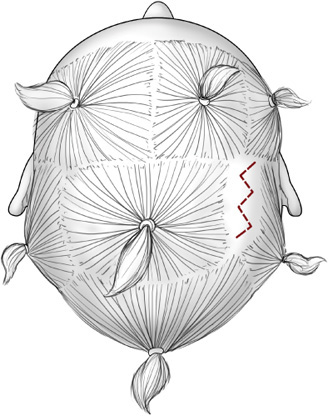Chapter 11. Calvarial Bone Harvest
 Indications: The calvarium provides an excellent donor source when bone is necessary for reconstruction. It may be safely harvested to reconstruct a nose with deficient structural support. The adult skull consists of outer and inner tables of dense cortical bone separated by the diploic space, a layer of cancellous bone. Either the full outer table of bone or a thinner shaving of the outer table can be safely obtained as graft material.
Indications: The calvarium provides an excellent donor source when bone is necessary for reconstruction. It may be safely harvested to reconstruct a nose with deficient structural support. The adult skull consists of outer and inner tables of dense cortical bone separated by the diploic space, a layer of cancellous bone. Either the full outer table of bone or a thinner shaving of the outer table can be safely obtained as graft material.
 Markings: Bone from the skull is best harvested from the flatter lateral areas of the parietal bone. Care should be taken not to harvest bone over the midline to avoid serious injury to the intracranial sagittal sinus. A gentle zig-zag incision is drawn parallel to the supraorbital neurovascular bundle to minimize postoperative paresthesia and visibility of the incision, especially when the hair is wet (Figure 11-1).
Markings: Bone from the skull is best harvested from the flatter lateral areas of the parietal bone. Care should be taken not to harvest bone over the midline to avoid serious injury to the intracranial sagittal sinus. A gentle zig-zag incision is drawn parallel to the supraorbital neurovascular bundle to minimize postoperative paresthesia and visibility of the incision, especially when the hair is wet (Figure 11-1).
Figure 11-1. Location of a scalp incision for calvarial bone harvest.
 Approach: The skin of the scalp does not need to be shaved prior to the incision but surgical lubrication is useful to keep the hair against the scalp. Liberal use of local anesthetic with epinephrine should be infiltrated and allowed time to work before beginning. The skin is incised with a scalpel and dissection proceeds down to the periosteum with electrocautery to minimize bleeding. The skin incision within the hair-bearing tissue can be beveled to minimize damage to the hair follicles and resultant postoperative scar alopecia. The desired amount of bone is outlined on the periosteum with the electrocautery.
Approach: The skin of the scalp does not need to be shaved prior to the incision but surgical lubrication is useful to keep the hair against the scalp. Liberal use of local anesthetic with epinephrine should be infiltrated and allowed time to work before beginning. The skin is incised with a scalpel and dissection proceeds down to the periosteum with electrocautery to minimize bleeding. The skin incision within the hair-bearing tissue can be beveled to minimize damage to the hair follicles and resultant postoperative scar alopecia. The desired amount of bone is outlined on the periosteum with the electrocautery.
 Partial cortical harvest: For thinner bone, the periosteum should be left intact so that it serves to hold smaller fragments of bone together. A wide, sharp osteotome is directed at the skull and advanced at roughly a 45-degree angle. The graft that is produced will fragment and tend to curl on itself but should be sufficient for areas where thin, non-weight-bearing bone is required.
Partial cortical harvest: For thinner bone, the periosteum should be left intact so that it serves to hold smaller fragments of bone together. A wide, sharp osteotome is directed at the skull and advanced at roughly a 45-degree angle. The graft that is produced will fragment and tend to curl on itself but should be sufficient for areas where thin, non-weight-bearing bone is required.
 Full cortical harvest: To obtain a full table of calvarial bone, a thin channel is made with a fissure burr around the periphery of the area of bone desired (Figure 11-2
Full cortical harvest: To obtain a full table of calvarial bone, a thin channel is made with a fissure burr around the periphery of the area of bone desired (Figure 11-2
Stay updated, free articles. Join our Telegram channel

Full access? Get Clinical Tree



